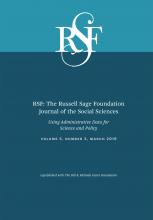Research Article
Open Access
Educational Opportunity in Early and Middle Childhood: Using Full Population Administrative Data to Study Variation by Place and Age
Sean F. Reardon
RSF: The Russell Sage Foundation Journal of the Social Sciences March 2019, 5 (2) 40-68; DOI: https://doi.org/10.7758/RSF.2019.5.2.03
Sean F. Reardon
aEndowed Professor of Poverty and Inequality in Education at the Stanford Graduate School of Education, Stanford University

References
- ↵
- Abdulkadiroglu, Atila,
- Joshua Angrist,
- Susan Dynarski,
- Thomas J. Kane, and
- Parag Pathak
- ↵
- Alexander, Karl L.,
- Doris R. Entwisle, and
- Linda S. Olson
- ↵
- Alexander, Karl L.,
- Doris R. Entwisle, and
- Linda Steffel Olson
- ↵
- Bloom, Howard S.,
- Carolyn J. Hill,
- Alison Rebeck Black, and
- Mark W. Lipsey
- ↵
- Bloom, Howard S., and
- Rebecca Unterman
- ↵
- Bond, Timothy N., and
- Kevin Lang
- ↵
- Bowles, Samuel, and
- Herbert Gintis
- ↵
- Boyd, Donald,
- Hamilton Lankford,
- Susanna Loeb, and
- James Wyckoff
- ↵
- Center for Research on Education Outcomes (CREDO
- ↵
- Chetty, Raj,
- John N. Friedman,
- Emmanuel Saez,
- Nicholas Turner, and
- Danny Yagan
- ↵
- Chetty, Raj,
- Nathaniel Hendren,
- Patrick Kline, and
- Emmanuel Saez
- ↵
- Chingos, Matthew M., and
- Kristin Blagg
- ↵
- Coleman, James S.,
- Ernest Q. Campbell,
- Carol J. Hobson,
- James McPartland,
- Alexander M. Mood,
- Frederick D. Weinfeld, and
- Robert L. York
- ↵
- Dadey, Nathan, and
- Derek C. Briggs
- ↵
- Darling-Hammond, Linda
- ↵
- Dobbie, Will, and
- Roland G. Fryer Jr.
- ↵
- ↵
- Downey, Douglas B.,
- Paul T. von Hippel, and
- Beckett A. Broh
- ↵
- Duncan, Greg J., and
- Jeanne Brooks-Gunn
- ↵
- Duncan, Greg J.,
- Jeanne Brooks-Gunn, and
- Pamela Kato Klebanov
- ↵
- Duncan, Greg J., and
- Katharine A. Magnuson
- ↵
- Entwisle, Doris R., and
- Karl L. Alexander
- ↵
- Fahle, Erin M.,
- Benjamin R. Shear,
- Demetra Kalogrides,
- Sean F. Reardon,
- Richard DiSalvo, and
- Andrew D. Ho
- ↵
- Hanselman, Paul, and
- Jeremy E. Fiel
- ↵
- ↵
- Ho, Andrew D
- Ho, Andrew D
- ↵
- Jencks, Christopher
- ↵
- Kozol, Jonathan
- ↵
- Kozol, Jonathan
- ↵
- Lankford, Hamilton,
- Susanna Loeb, and
- James Wyckoff
- ↵
- Nisbett, Richard E
- ↵
- Nisbett, Richard E
- ↵
- Nisbett, Richard E.,
- Joshua Aronson,
- Clancy Blair,
- William Dickens,
- James Flynn,
- Diane F. Halpern, and
- Eric Turkheimer
- ↵
- Phillips, Deborah A., and
- Jack P. Shonkoff
- ↵
- ↵
- Reardon, Sean F
- ↵
- Reardon, Sean F
- ↵
- Reardon, Sean F.,
- Erin M. Fahle,
- Demetra Kalogrides,
- Anne Podolsky, and
- Rosalia Zarate
- Reardon, Sean F.,
- Andrew D. Ho,
- Benjamin R. Shear,
- Erin M. Fahle,
- Demetra Kalogrides, and
- Richard DiSalvo
- ↵
- Reardon, Sean F.,
- Demetra Kalogrides, and
- Andrew D. Ho
- ↵
- Reardon, Sean F.,
- Joseph P. Robinson-Cimpian, and
- Ericka S. Weathers
- ↵
- Reardon, Sean F.,
- Benjamin R. Shear,
- Katherine E. Castellano, and
- Andrew D. Ho
- ↵
- Sampson, Robert J.,
- Patrick Sharkey, and
- Stephen W. Raudenbush
- ↵
- Shores, Kenneth, and
- Matthew Steinberg
- ↵
- Sirin, Selcuk R
- ↵
- ↵
- Torats-Espinosa, Gerard
- ↵
- ↵
- von Hippel, Paul T.,
- Joseph Workman, and
- Douglas B. Downey
- ↵
- Wodtke, Geoffrey T.,
- David J. Harding, and
- Felix Elwert
- ↵
In this issue
Educational Opportunity in Early and Middle Childhood: Using Full Population Administrative Data to Study Variation by Place and Age
Sean F. Reardon
RSF: The Russell Sage Foundation Journal of the Social Sciences Mar 2019, 5 (2) 40-68; DOI: 10.7758/RSF.2019.5.2.03
Jump to section
Related Articles
- No related articles found.
Cited By...
- No citing articles found.





